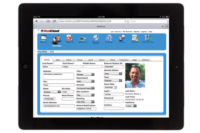Video surveillance technology is a very powerful tool that can not only help prevent criminal activity and catch criminals, but it can also be used as a very effective management tool to document and track the actions of employees, including adherence to company policies, improving customer service, identifying the best retail merchandising plans, managing vehicular traffic, and much, much more.
As a result, surveillance and security system designers spend considerable time and effort determining the best possible cameras to use to provide maximum video coverage and analytics data for the variety of applications installed at customer locations. Managing this potentially vast amount of data is the key function of a Video Management System (VMS).
VMS effectiveness is measured in many ways and performance is dictated by several factors. VMS systems can succeed or fail in their ability to support specific applications. Moreover, as surveillance systems age, they often become more complex than when they were initially installed, as the technology associated with them continues to move at a rapid pace, irrespective of whether or not the VMS keeps up. Cameras may be upgraded, new requirements such as License Plate Recognition, Access Control, advanced analytics and others may come into play, further complicating the VMS solution. Choosing the right VMS provider capable of addressing these and other potential requirements and challenges is a complex – but critically important – step. Choosing the right VMS solution helps to ensure that the implemented system will continue to be efficient and effective now and into the future, and that it will deliver the video and data you need when you need it most. Sustained and continued VMS relevancy is paramount.
There are a number of important criteria to consider during the VMS selection process. Below is a checklist of criteria to help you choose the best VMS solution to support both your immediate and longer-term security and operational objectives.
Competitive Licensing: By nature, all software must be registered and licensed, which also holds true for VMS software. One important factor for consideration is whether a solution allows you to mix and match licenses to maximize the system’s effectiveness and keep costs under control. Additionally, look for solutions that offer full backward compatibility and the ability to add licenses as fast, easy and cost-effectively as possible to allow for system expansion or alterations as your organization’s needs change. Also, it is important to note that some VMS providers have very complicated Software Upgrade Plans (SUP) that tie post sale support, bug fixes and patches to it. Consider a VMS that offers a simple and low restriction SUP plan.
Hardware Efficiencies and Scalability: Hardware costs can significantly inflate the overall price tag of any security installation, which poses problems if you’re dealing with an established budget. Look for a VMS solution that allows more cameras to be connected to each server, provides for the use of low cost SATA hard drives and allows for direct network attached storage (NAS) recording that can reside remotely, anywhere on the network. All of these add up to lower overall hardware costs for any size installation.
Ease of Installation: In addition to hardware, another big contributor to up-front system expenditures is the cost of installation. The more labor-intensive the installation, the more time it requires, and the more it will cost. To reduce these expenses and make a system more cost-effective, choose a VMS that does not require time-consuming and labor-intensive manual configuration. Look for VMS solutions that don’t require MAC addressing, do not require cameras to be mapped to hard drives, and that include a fast and easy way to use camera locating tools. Shortening installation time is a big cost saver!
Network and Video Security: Users should choose a VMS that takes network and video security as seriously as they do. Pick a VMS that supports full encryption between clients and server and supports HTTPS between the cameras and servers. This will assure end-to-end encryption of all data. Additionally, look for a VMS that randomizes the recorded video database, so that recorded information cannot be manipulated and reinserted by anyone, including IT personnel.
Smart Camera Drivers: Chose a VMS that provides the technology necessary to immediately use newly introduced cameras from most major manufacturers without having to wait for individual camera drivers to be written. This allows for quicker deployments of new camera features and benefits to further enhance the VMS solution.
Remote Troubleshooting: Like installation, maintenance costs can vary depending on the amount of time required for a technician to address an issue. Many problems that arise with software can be quickly and easily fixed by someone who understands the solution well. Often there is a minimum charge associated with on-site maintenance, so if a technician has to be physically be on the premises to address a problem, even the simplest fix can be expensive. Thankfully, advanced VMS solutions offer the ability for technicians to remotely access systems to diagnose or even fix an issue without the need to visit your site. Should the problem be significant enough to require a site visit, a technician can be dispatched to a location knowing exactly what is wrong and how to fix it before they arrive.
Automatic Updates and Upgrades: Software providers continuously develop and deliver updates, upgrades and patches to ensure the stability, performance and security of their solution. The same holds true for VMS solutions. Integrators are often responsible for making sure software updates are installed, but the cost of performing site visits can be substantial, especially if you have recording servers in multiple locations that need to be updated individually. Look for a VMS that includes capabilities that enable automatic patching and updating of software, including camera drivers that later eliminate the need for costly server-by-server updating.
Free Technical Support: A VMS provider should offer free technical support through multiple channels, including phone, web and apps. In addition, technical support should be available to all customers, without the purchase of a care package or service agreement.
Enterprise Level Integration: Increasingly, VMS solutions are functioning as a main platform for integrated security systems, connecting and collecting data from video, access control, time and attendance and other security and non-security systems. Open architecture is the foundation for integrated systems allowing event fusion, combining video data from other alarm generating systems to generate meaningful alerts that heighten security and deliver added value, including the ability to dramatically minimize false alarms, improve the value and effectiveness of an operator and improve compliance and other operational functions.
Ability to Evolve: The security landscape is constantly changing with new products and technologies continually coming to market, including HD and UHD cameras, advanced video analytics and networked access control solutions. Users need to select a VMS provider that offers the flexibility and agility to quickly and easily accommodate new solutions. This helps ensure that users get the most up-to-date solutions possible with greater value.
Careful evaluation of a VMS provider using these simple references will help you to choose the best solution for your specific video application and needs – one that will provide benefits for security and overall operations. While this process may initially be exhaustive, the benefits are well worth the extra up-front effort to ensure you make the best choice when selecting a VMS solution.




